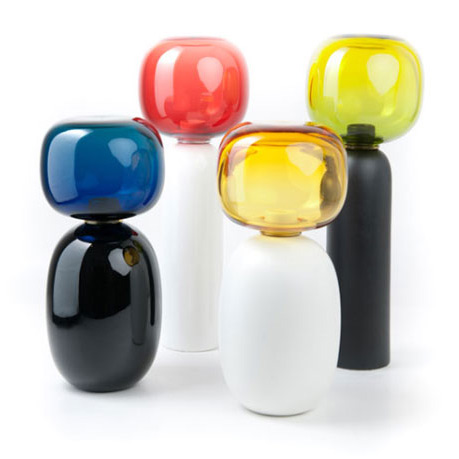Kokeshi: From Folk Art to Art Toy

by Julie Wolfson
The exhibit, "Kokeshi: From Folk Art to Art Toy" pays homage to traditional Japanese Kokeshi, brightly painted wooden dolls with no arms or legs, at the LATDA in collaboration with the Japanese American National Museum (JANM) in downtown Los Angeles. A giant crocheted doll by Emi Motokaw greets museum goers at the entrance, welcoming them into the three-part exhibit. The first part shows Itske and Anthony Stern's collection of traditional Kokeshi, followed by 11 contemporary artists' original takes on the Kokeshi in diverse media. For the third section entitled "Custom Kokeshi 2009," curator Christina Conway gave over 100 artists an identical blank Kokeshi form to create pieces of art.
Cool Hunting asked Conway to tell us more about the world of customized toys, the artists and the surprises she found along the way.
What inspired you to do this show?
I started collecting a few random vinyl toys a few years ago, but was always on the lookout more feminine pieces. I loved the idea of the same toy customized by a series of artists, but I wanted to see more diversity in the style of art. I remember talking to different toy designers at Comic-Con and asking why more women were not included, everyone just laughed and shrugged it off. The vinyl toy market is rather male oriented, considering that most designs are created "kawaii" style, it's a bit ironic there are not more girls dominating the scene. With my custom shape based on a feminine form I have been trying to introduce finer art to the custom toy world. So many talented artists, illustrators and designers were being overlooked. I wanted to see my favorite people work on a 3-D form too. After a series of events, I looked into creating my own show. Don and Dylan of Subtext Gallery were open to seeing what I could do. I have them to thank for getting the project started, without someone willing to try something new none of this could have happened.
How did you choose the artists?
I have an on-going list of hundreds of artists I follow, admire or am inspired by. I bookmark many many blogs and websites, including Cool Hunting, and find more people every day that impress me. And I go from there! I put the first show together in three months, with over 80 artists and found most everyone were really intrigued by the kokeshi and ready to contribute work. Most of the artists I contact have never spoken with me before, I'm like a kid in a candy store writing, talking and meeting all these creative people I've only known from a distance.
Which artist’s kokekshi surprised you the most?
The fact that there is such diversity always impresses me. This year I invited artists who work in other media besides paint and the results were truly amazing. I really love that Tessar worked with clay this year, his first piece in the 2007 show was incredible. This newest one is a true reflection on how his work is changing. I think he took the bull by the horns and just went for it. It was liberating to see him not being limited by the shape. The other kokeshi that really have me giddy are the three pieces Mike Rivamonte created from clarinets, photo equipment, and the blank kokeshi. I had seen his vintage inspired robots online and was curious to know if he could make kokeshi the same way. I've been trying to trade some old clarinets from junior high and highschool as credit toward purchasing one, but Mike is looking for more vintage instruments… I still hope to see my neglected clarinets find a home in his work, it's such a great form of recycling.
How did you get involved with the exhibit at the Japan America Museum?
Scott Brown of Spicy Brown discovered my 2007 kokeshi show and told Maria Kwong, an avid toy collector and the Director of the Los Angeles Toy, Doll and Amusements Museum. Maria contacted me and visited the show at Subtext. She told me about an exhibit she was working on that was all about kokeshi and asked if I would be interested in putting together another custom show. I already knew I wanted to do the show again, so this opportunity with such an amazing venue was an wonderful opportunity for me and for the artists I support. I jumped at the chance. I have Maria to thank for making all this possible, she works magic!
What's next for the Kokeshi project?
I'm keeping my fingers crossed for some projects that have been mentioned to me, until then I'll keep the next show under wrap until I know more. Meanwhile, I am designing a photography book with all the images of the custom kokeshi from 2007 and 2009. There's never been a budget for a show catalog, so I hope to eventually make up for that with one large and in-depth book.
What else are you working on?
By day I am a full-time graphic designer with a specialty and fondness for surface pattern design. I have been fortunate enough to stay busy on projects and continue to scour the web, magazines and galleries for art that inspires my own design work. I paint a little on the side when I get the opportunity.
The custom Kokeshi are available through the JANM Museum store. (Most are between $120-$750.)
Kokeshi: From Folk Art to Art Toy
Through 6 October 2009
Japanese American National Museum
369 East First Street
Los Angeles California 90012 map
tel. +1 213 625 0414











